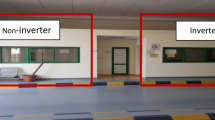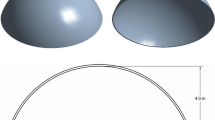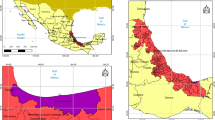Abstract
The residential building sector is one of the major areas to reduce energy demand. In this study, the single-sided top vent-based natural ventilation parameters are optimized using Taguchi technique. The computational fluid dynamics tool is used to simulate the room model. The grid sensitivity analysis is executed to predict more precise results. The operating parameters for top vent and window-based ventilation investigated are top vent width, top vent height, the location of the top vent, the number of top vents and window type with different levels. The orthogonal array, L8, is selected for the conduct of experiments. The signal-to-noise ratio and analysis of variance technique are used to optimize the results. The optimized results showed that the maximum top vent width, top vent height and more number of vents with higher window opening area reduce the maximum indoor air temperature and increase the mass flow rate of a single-sided residential room. Of all, around 60.64% numbers of top vents contributed to indoor temperature reduction. In addition, thermal exergy is also investigated on various vent sectional planes.















Similar content being viewed by others
Abbreviations
- ρ :
-
Density (kg m−3)
- ρ 0 :
-
Reference density (kg m−3)
- Δρ :
-
Density difference (kg m−3)
- Δp :
-
Pressure difference (Pa)
- V :
-
Velocity vector
- φ :
-
Mean velocity (m s−1)
- Γ φ :
-
Diffusion coefficient
- S φ :
-
Source term
- T :
-
Temperature (K)
- T 0 :
-
Reference temperature (K)
- α :
-
Thermal expansion coefficient
- g :
-
Gravitational acceleration (m s−2)
- H :
-
Vertical distance between openings (m)
- ExgT :
-
Thermal exergy (J kg−1)
- Cp:
-
Specific heat capacity (J kg−1 K−1)
- S/N :
-
Signal-to-noise ratio
- n :
-
Simulation number
- Y i :
-
Resulting value of ith performance characteristics
References
Sorgato MJ, Melo AP, Lamberts R. The effect of window opening ventilation control on residential building energy consumption. Energy Build. 2016;133:1–13. https://doi.org/10.1016/j.enbuild.2016.09.059.
Jones RV, Fuertes A, Gregori E, Giretti A. Stochastic behavioural models of occupants’ main bedroom window operation for UK residential buildings. Build Environ. 2017;118:144–58. https://doi.org/10.1016/j.buildenv.2017.03.033.
Bayoumi M. Impacts of window opening grade on improving the energy efficiency of a façade in hot climates. Build Environ. 2017;119:31–43. https://doi.org/10.1016/j.buildenv.2017.04.008.
Psomas T, Fiorentini M, Kokogiannakis G, Heiselberg P. Ventilative cooling through automated window opening control systems to address thermal discomfort risk during the summer period: framework, simulation and parametric analysis. Energy Build. 2017;153:18–30. https://doi.org/10.1016/j.enbuild.2017.07.088.
Stazi F, Naspi F, D’Orazio M. A literature review on driving factors and contextual events influencing occupants’ behaviours in buildings. Build Environ. 2017;118:40–66. https://doi.org/10.1016/j.buildenv.2017.03.021.
Elshafei G, Negm A, Bady M, Suzuki M, Ibrahim MG. Numerical and experimental investigations of the impacts of window parameters on indoor natural ventilation in a residential building. Energy Build. 2017;141:321–32. https://doi.org/10.1016/j.enbuild.2017.02.055.
Yang X, Zhong K, Kang Y, Tao T. Numerical investigation on the airflow characteristics and thermal comfort in buoyancy-driven natural ventilation rooms. Energy Build. 2015;109:255–66. https://doi.org/10.1016/j.enbuild.2015.09.071.
Yang X, Zhong K, Zhu H, Kang Y. Experimental investigation on transient natural ventilation driven by thermal buoyancy. Build Environ. 2014;77:29–39. https://doi.org/10.1016/j.buildenv.2014.03.013.
Stavridou AD, Prinos PE. Unsteady CFD simulation in a naturally ventilated room with a localized heat source. Proc Environ Sci. 2017;38:322–30. https://doi.org/10.1016/j.proenv.2017.03.087.
Lenin VR, Sivalakshmi S, Raja M. Experimental investigation on single-sided transient natural ventilation driven by buoyancy. Therm Sci. 2017;21(2):S489–96.
Omrani S, Garcia-Hansen V, Capra B, Drogemuller R. Natural ventilation in multi-storey buildings: design process and review of evaluation tools. Build Environ. 2017;116:182–94. https://doi.org/10.1016/j.buildenv.2017.02.012.
Song Z. Studying the fan-assisted cooling using the Taguchi approach in open and closed data centers. Int J Heat Mass Transf. 2017;111:593–601. https://doi.org/10.1016/j.ijheatmasstransfer.2017.04.022.
Arslanoglu N, Yigit A. Experimental investigation of radiation effect on human thermal comfort by Taguchi method. Appl Therm Eng. 2016;92:18–23. https://doi.org/10.1016/j.applthermaleng.2015.09.070.
Suárez-López MJ, Blanco-Marigorta AM, Gutiérrez-Trashorras AJ, Pistono-Favero J, Blanco-Marigorta E. Numerical simulation and exergetic analysis of building ventilation solar chimneys. Energy Convers Manag. 2015;96:1–11. https://doi.org/10.1016/j.enconman.2015.02.049.
Matheswaran MM, Arjunan TV, Somasundaram D. Analytical investigation of solar air heater with jet impingement using energy and exergy analysis. Sol Energy. 2018;161:25–37. https://doi.org/10.1016/j.solener.2017.12.036.
Wang L, Li N. Evaluation of buoyancy-driven ventilation in respect of exergy utilization. Energy Build. 2010;42(2):221–9. https://doi.org/10.1016/j.enbuild.2009.08.019.
Gan G. Simulation of buoyancy-driven natural ventilation of buildings—impact of computational domain. Energy Build. 2010;42(8):1290–300. https://doi.org/10.1016/j.enbuild.2010.02.022.
Ravikumar P, Prakash D. Analysis of thermal comfort in a residential room with insect proof screen: a case study by numerical simulation methods. Build Simul. 2011;4(3):217–25. https://doi.org/10.1007/s12273-011-0032-9.
Cook MJ, Ji Y, Hunt GR. CFD modelling of natural ventilation: combined wind and buoyancy forces. Int J Vent. 2003;1(3):169–79. https://doi.org/10.1080/14733315.2003.11683632.
Gan G. Prediction of turbulant buoyant flow using an RNG k-ϵ model. Numer Heat Transfer Part A Appl. 1998;33(2):169–89. https://doi.org/10.1080/10407789808913933.
Wang J, Wang S, Zhang T, Battaglia F. Assessment of single-sided natural ventilation driven by buoyancy forces through variable window configurations. Energy Build. 2017;139:762–79. https://doi.org/10.1016/j.enbuild.2017.01.070.
Arulraj M, Palani PK. Parametric optimization for improving impact strength of squeeze cast of hybrid metal matrix (LM24–SiCp–coconut shell ash) composite. J Braz Soc Mech Sci Eng. 2017;40(1):2. https://doi.org/10.1007/s40430-017-0925-3.
Baburaj E, Mohana Sundaram KM, Senthil P. Effect of high speed turning operation on surface roughness of hybrid metal matrix (Al–SiCp–fly ash) composite. J Mech Sci Technol. 2016;30(1):89–95. https://doi.org/10.1007/s12206-015-1210-y.
Author information
Authors and Affiliations
Corresponding author
Rights and permissions
About this article
Cite this article
Lenin, V.R., Sivalakshmi, S. & Raja, M. Optimization of window type and vent parameters on single-sided natural ventilation buildings. J Therm Anal Calorim 136, 367–379 (2019). https://doi.org/10.1007/s10973-018-7913-4
Received:
Accepted:
Published:
Issue Date:
DOI: https://doi.org/10.1007/s10973-018-7913-4




